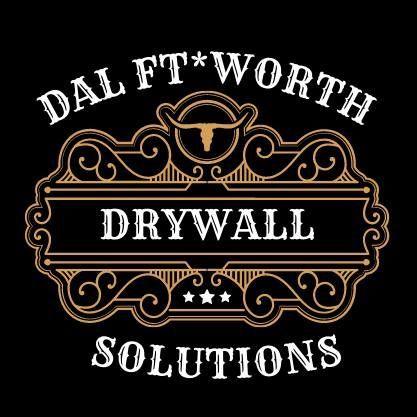Drywall Hanging Fort Worth, TX
How We Hang Sheetrock In Fort Worth, Texas
While you may think that installing drywall is as simple as leaning it against the wall, you'll be surprised to know that it takes significant measurement and planning to actually do it. Not only must the drywall itself be ordered in advance, but the drywall must be able to be delivered to the job site and installed indoors seamlessly. This means that we will have to take into account the space between windows, doors and rooms in the best ways to deliver and install large drywall sheets.
Professional Team for Drywall Hanging
To install drywall or hang them, you usually need a team of professionals who can do the heavy lifting. Drywall is built in frames that are hung or mounted on the walls of the workspace. The goal is to achieve flat, even walls once the entire drywall has been hung. Drywall can also be hung on ceilings to give rooms a cohesive appearance. Professional drywall contractors in Fort Worth TX will also be able to hang your drywall without the appearance of seams between the panels, obvious fasteners, or other tools that help keep the drywall in place.
Drywall hanging is a more convenient and efficient way of hanging drywall. Drywall hanging is a method used to hang drywall on walls, ceilings, and floors by using wood, nails, and screws. This method has been around for decades and is still commonly used today. The benefits of drywall hanging are as follows:
Convenience is the obvious advantage. Unlike applying the drywall anchors with nails or screws through the walls or ceiling, you don't have to remove them, pull them out, and replace them after you're finished. When using drywall hanging, you can simply pull up on the panels and slip the panels over the edges of the frame and leave the nails or screws in place. You don't have to worry about nailing and screwing up a series of frames over again just to make your way from room to room. You save both time and money by not having to do it that way.
Other Benefits:
Another benefit is safety. When doing drywall hanging by yourself without the aid of a helper, you can be much safer than if you were to do it by yourself. When installing drywall yourself, you are at greater risk for hurting yourself from slipping or falling over because you can't get the panel edges against the wall behind you, which can lead to a nasty cut or split when you apply the first layer of joint compound (the drywall adhesive). By using a utility knife with a scored line on the blade and applying the joint compound with a drywall knife with a scored line on the blade, you reduce your risk for injury.
Safety doesn't even have to be an issue if you use joint compound that conforms to the profile of the drywall hanging panel edges. Even the most inexperienced drywall hanging operator should have no problem keeping his fingers out of the way of the compound and avoiding a cut. The utility knife with a scored line makes it easy to keep one hand in front of the panel and the other in front of the utility knife. This is especially important if the panel is installed on top of a framed wall or floor panel.
Safety and Precision in Drywall Hanging
If you are going to use a hoist to hang drywall, make sure you don't cut yourself. A hoist should have the ability to move the panel from inside the house to out of the house. Even if you install the hoist yourself, there's a chance you won't get it perfectly straight and the nails may get thrown off or into your studs. A tool with both a straight and a sloping cutting edge will reduce the chances of these problems. Nails, screws, and nails can also cause problems if they are not correctly placed and used. The nails and screws are placed either through the centers of the studs or along a straight edge. With hanging drywall on studs, you need to make sure that the nails are placed at least six inches apart and parallel. For the edges of studs, use nails of different sizes but be careful that they are all straight. You don't want any gaps or holes in your wall.
Ensuring Proper Installation and Finishing
To ensure that your studs are even drill a small hole and place the fasteners through. Then use a level and adjust the height until you find the level that works best. Keep in mind that the spaces between the fasteners and the studs can widen, so placing the fasteners evenly will save you money. It also keeps your hanging experience from being a disaster. The finishing touch in hanging drywall is done using a finishing nail or screw. This is done first so you don't have to worry about nailing the first step. Place the finishing nail or screw into the stud and screw tightly. Use finishing oil or glue to make sure that the surface is smooth before it gets tapered.
When hanging drywall, it's crucial to consider various factors that contribute to a successful installation. One of the primary concerns during drywall installation is ensuring the material's integrity, especially in areas prone to water exposure like bathrooms, basements, or near plumbing fixtures. Waterproofing measures are essential to prevent water damage and mold growth. Using gypsum drywall with a water-resistant coating is highly recommended in such areas.
In regions where extreme weather conditions are common, such as excessive heat or humidity, proper insulation is necessary to maintain the drywall's durability. Insulation contractors can help with this aspect, ensuring that the walls and ceilings are adequately insulated to withstand temperature fluctuations. Additionally, soundproofing can be integrated into the drywall hanging process to enhance the acoustic quality of your home, making it a more comfortable living space.
For homes with a history of pest issues, combining drywall hanging with pest control measures can be beneficial. Sealing all potential entry points with joint compound during the drywall installation can help keep pests at bay. Furthermore, incorporating fiberglass insulation behind the drywall can add an extra layer of protection against insects and rodents.
When undertaking a renovation project that involves drywall hanging, it’s important to coordinate with other trades such as electricians and plumbers. Ensuring that electrical wiring and plumbing are correctly installed before hanging the drywall prevents the need for costly repairs and modifications later on. A general contractor can oversee these aspects, ensuring a smooth and coordinated effort across all areas of the renovation.
Another critical consideration is the cost associated with drywall hanging. While professional installation may seem like an added expense, it often proves to be cost-effective in the long run. Professionals ensure that the drywall is hung correctly, reducing the likelihood of future damage and the associated repair costs. It's also worth checking with your insurance provider to see if your policy covers any damage related to improper drywall installation or subsequent water damage.
To maintain the aesthetics and integrity of the drywall, proper finishing techniques are crucial. This includes applying a smooth layer of plaster and paint to achieve a polished look. For exterior walls, integrating construction elements like concrete can enhance the structure's durability and resistance to environmental factors.
Incorporating landscaping elements such as lawn maintenance around the home can also play a role in protecting your drywall. Proper drainage systems around the landscape prevent water from seeping into the basement or foundation, reducing the risk of water damage to the drywall. Pressure washing the exterior walls can also help maintain their appearance and prevent mold growth.
Choosing Reliable Drywall Contractors
At Fort Worth Drywall Contractor Services, we understand the importance of a seamless and professional drywall hanging process. We take pride in our meticulous attention to detail and our ability to coordinate with other services, such as carpentry, basement waterproofing, and soundproofing. To learn more about our comprehensive approach, be sure to check out our latest blog posts. By ensuring that all elements—from the initial drywall installation to the final paint job—are executed flawlessly, we provide a comprehensive solution for your home renovation needs. Our team, comprised of skilled handymen and general contractors, is committed to delivering top-notch quality. Whether you need drywall for a new construction project or repairs for drywall damage, we are here to assist you in every step of the process. If you have any questions or need a quote, don't hesitate to contact us today.
Lastly, when searching for reliable drywall hanging services, consider checking the company’s reputation with the Better Business Bureau and reading reviews from past clients. This helps ensure you hire a reputable and experienced contractor who can deliver quality work within your specified zip code. At Fort Worth Drywall Contractor Services, we take pride in our comprehensive approach to drywall hanging, ensuring every aspect of the project is meticulously planned and executed to meet your specific needs.
Frequently Asked Questions for Drywall Hanging
What tools do I need to hang drywall?
To hang drywall, you’ll need the following tools:
Utility knife for cutting
Drywall saw or keyhole saw for openings
Screw gun or drill for attaching screws
T-square or straight edge for accurate cuts
Tape measure
Drywall screws (preferably 1 1/4 inch or 1 5/8 inch)
How do I determine where to hang drywall first?
Start by hanging drywall on the ceiling first, if applicable, followed by the walls. Hanging the ceiling first provides better support for the wall sheets. When installing on walls, work from the top down to avoid unnecessary gaps.
How far apart should drywall screws be placed?
Drywall screws should be spaced about 12 inches apart on the studs for walls and 8 to 10 inches apart for ceilings. Make sure to sink the screws just below the surface without breaking the paper layer.
How do I cut drywall for electrical outlets or fixtures?
Measure the location of the outlet or fixture, then use a keyhole saw or drywall saw to carefully cut the hole. Double-check your measurements to avoid mistakes, and cut slightly smaller than needed, trimming as necessary to fit.
How do you prevent cracking or breaking drywall while hanging it?
Handle drywall sheets carefully to avoid breaking them, especially along the edges. Make sure the sheets are fully supported when moving or cutting them. When hanging drywall, avoid over-tightening screws, as this can cause cracking around the fasteners.


"I was repainting my son’s room in our house and he wanted a textured wall so I called up the guys at Fort Worth Drywall Solutions to do the job. They applied a wet drywall mixture to the existing drywall to make the area textured, left it to dry, and then applied paint on top of it. My son loves his new room!”
– Charles G
I had been looking to have spray foam my attic for better insulation. The team at Fort Worth Drywall Solutions were very helpful when it came to scheduling the spray foam appointment and the aftercare for our attic. They assured me I would see a change in my energy bills and I did within the first few months!”
– Carey L
When I was remodeling my home, I really needed a drywall contractor to install sheets in our living room. I was so fortunate to have come across Fort Worth Drywall Solutions. They were super friendly and welcoming to my wishes and accommodated to my schedule. Thanks, Forth Worth Drywall Solutions!”
– Andrea R
Contact US
To learn more about our current range of products and services, you can get incontactwith us via the telephone number listed on our website. On this number, one of our customer service agents will be more than happy to assist you by answering any questions or scheduling appointments for your drywall, as needed. If you would rather write us an email or would like to receive an estimate for a service you’re interested in, at no extra cost, you can do so by filling in the contact form on our website and we’ll respond to you as soon as possible. Our drywall contractor company offer services on multiple locations.
Visit our blog page to explore in-depth information and insights about the wide range of services our skilled experts offer. Learn how they can cater to your specific needs with their expertise and experience.
Working hours
- Mon - Sun
- -
Copyright ©Fort Worth Drywall Solutions | Proudly Powered by Snapps | SEO






